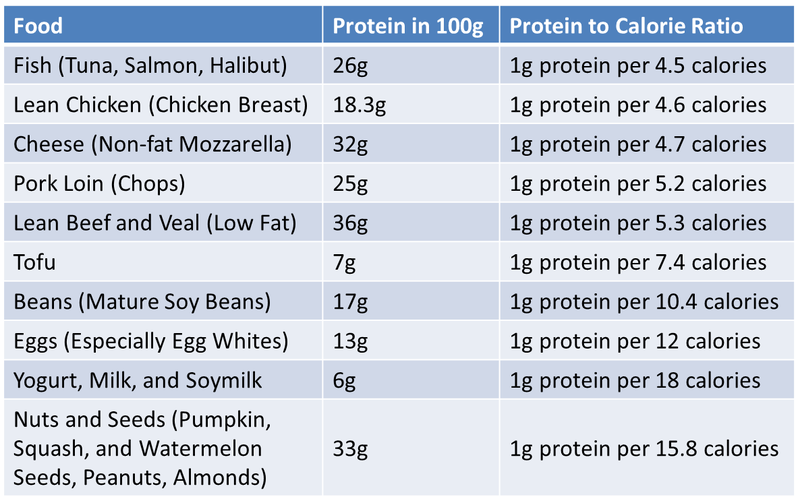Protein is one of several macro nutrients that we all need for our bodies to grow and function properly. Experts still debate about the amount of protein we need to eat each day. At the moment, the RDI (recommended daily intake) for women between ages 19 and 70 is 46 grams and it is 56 grams for men in this age range. Excess protein will be converted by the body into energy and experts are still unsure whether this excess leads to stress on your liver. Protein deficiency, on the other hand, is known to cause impaired overall functioning as well as muscle atrophy. As such, if you aren’t getting enough, you need to learn how to get more protein in your diet.

How to Eat More Protein
Understand Your Protein Needs
The very first step of knowing how to get more protein is to understand your body’s needs. The numbers listed above are general guidelines, but the DRI (dietary reference intake) recommends that anyone over age 19 eats 0.8 grams of this macronutrient for each kilogram of their body weight daily. Following this rule would give you just enough protein to prevent a deficiency and let your body perform baseline functions.
If you regularly perform taxing endurance activities or resistance training, then you need to consume much more protein, leading to the need to learn how to eat more protein. Your body needs protein in order to reach optimal performance, adapt to new challenges, and synthesize muscle as a response to the challenges. Athletes should aim to eat 1.3 to 1.8 grams of protein for every kilogram of their body weight so their body can optimally adapt.
If you want to lose weight, you should look into how to eat more protein. If your goal when adding protein to your diet is purely for weight loss, aim for around 120 grams (4.23 ounces) daily, with some variation for health status and gender.
Have More Protein at Each Meal
The easiest method of how to eat more protein is to add a bit to every meal in the form of animal-based or plant-based proteins. You can easily reach your protein consumptions goals by eating a range of foods without needing to plan extra, especially if you eat animal products. The average person who eats the recommended amount of lean protein, vegetables, grains, and dairy each day will get enough protein.
Work to swap out any meat you currently eat with lean options. Lean meats with high protein content include fish, turkey, chicken, and low-fat cuts of lamb, pork, or beef.
You should also try eating more cottage cheese. Every cup of this protein-packed food has 28 grams (0.98 ounces) of protein. To add the flavor and boost your protein consumption even more, mix in almonds or fruit. You can also find delicious recipes with cottage cheese or more mix-in ideas online.
Select vegetables which have high amounts of protein, with potatoes, onions, mushrooms, asparagus, cauliflower, spinach, and broccoli being some of the best options. Either eat your vegetables raw or make them by steaming or in a stir-fry as this lets the vegetables keep their protein and nutrients. When you boil them, you can lower nutrient amounts. Luckily, protein cannot be cooked off, so if your only concern is protein, choose your favorite cooking method.
Instead of relying on expensive protein supplements to add to your shakes, learn how to eat more protein by blending up tofu. Because tofu doesn’t have its own distinct flavor, it is the perfect addition to smoothies with fruit or veggies. As a bonus, it is considered a complete protein.
Select Snacks High in Protein, Not Carbs
Always try to keep your energy high when you are on the go and a great way to do this is with high protein snacks. As a bonus, they let you feel fuller longer than a snack high in carbs would because your body needs more time to break down protein. Ideal high-protein snacks include a few slices of lean meat, Greek yogurt, almonds or other nuts, and hard boiled eggs.
Also try to eat seeds, beans, and nuts. Peanut butter, unsalted peanuts, edamame beans, chickpeas, and sunflower seeds are all high in protein and easy to carry around with you for a snack while on the go.
To prevent issues, a good method of how to get more protein is to keep a small bag with nuts with you at all times. Eat the snack if you have low energy or are hungry. Having the snack ready stops you from turning to snacks without proteins, which may make you eat more overall.
Select Drinks Rich in Protein
Instead of picking a standard soda, glass of water, or cup of juice, aim for drinks rich in protein. You can either buy them or make some of your own. It is especially easy to make your own smoothies with plenty of protein.
Use Protein Supplements
If you need to, you can always turn to protein supplements or protein powder. You can easily add the powder to specific drinks or food items to improve your daily intake. This is a great method for those who don’t get enough protein in their current diet. If you do get a lot of protein throughout the day, however, you probably don’t need protein powder.
Try adding protein powder with vanilla-flavor to your morning cup of coffee. You can also mix it into dishes as you cook, such as muffins, oatmeal, or pancakes. Always talk to your doctor before taking a supplement, including protein.



View All Comments /Add Comment